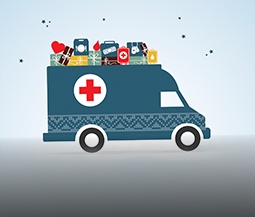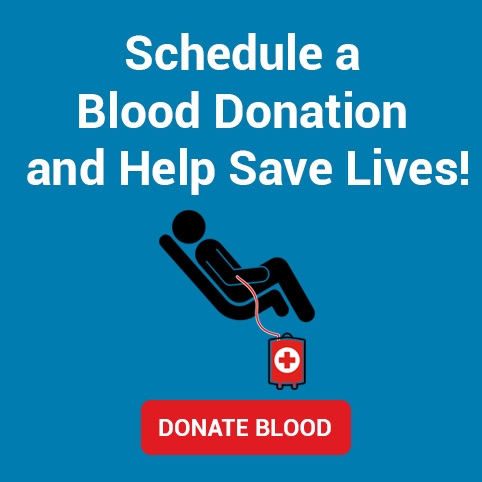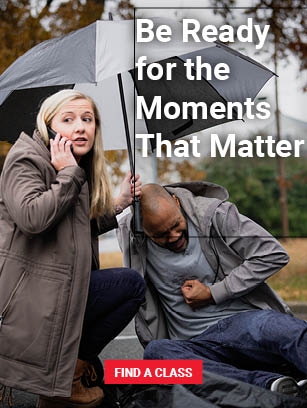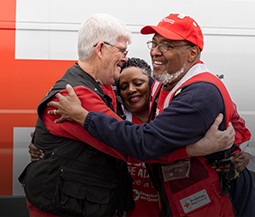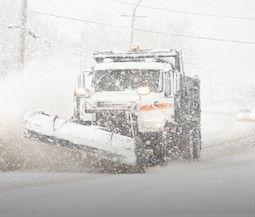If you live in an area at risk for hurricanes, have a plan
to evacuate and a plan to shelter safely at home.
Two weather systems in the Atlantic Ocean could rapidly strengthen into tropical storms or hurricanes in the coming days and be named Humberto and Imelda. These systems may pose a threat to parts of the Southeastern United States early next week.
Much of the same region which may be affected is still recovering from Hurricane Helene, the storm leaving heartbreaking devastation behind just one year ago. The American Red Cross is still helping those affected through our Long-Term Recovery program. Learn about our continuing support here.
The Red Cross urges anyone who could be impacted to get ready now and is preparing to respond across a wide area stretching from the Carolinas into Virginia and the Appalachian Mountains. We are working with community partners as well as state and local emergency management officials to ensure help will be available if it is needed. The Red Cross is focused on identifying shelter locations, mobilizing trained disaster volunteers and readying relief supplies and emergency vehicles.
STEPS YOU SHOULD TAKE TO GET READY Hurricanes not only cause problems for people in coastal areas but can also cause damage hundreds of miles inland. If you live on the coast, you are most at risk for extreme winds and flooding from rain and storm surge. Live inland? You are at risk for wind, thunderstorms, flooding and power outages.
Have a plan to evacuate and a plan to shelter safely at home.
- Your evacuation plan should include knowing where you’ll go, how you’ll get there, and where you’ll stay. Your stay-at-home plan should focus on gathering the right supplies so that you can live safely without power, water, gas, phone or internet for a long time.
- Decide how you will reconnect with loved ones if you are separated or if the phone or internet is down. Write down important phone numbers on a contact card and carry it with you.
- Be able to monitor local weather and news reports even if the power goes out. Have a backup battery or another way to charge your cell phone, and a battery-powered or hand-crank radio.
- Sign up for free emergency alerts from your local government.
- Gather critical supplies — food, water and medicine — and organize them into a three-day go-kit and a two-week stay-at-home kit. Include a month’s supply of medications and medical supplies If needed.
- If you have pets or young children, include items they will need.
- Keep your personal, financial and medical records in a safe place that’s easy to access (hard copies or securely backed up). Consider keeping a list of your medications and dosages on a small card to carry with you.
DON’T FORGET TO: Download the free Red Cross First Aid app so you’ll know what to do if emergency help is delayed and the free Emergency app for weather alerts, open Red Cross shelter locations and safety steps for different emergencies. Choose whether you want to view the content in English or Spanish with an easy-to-find language selector. Find these and all of the Red Cross apps in smartphone app stores by searching for the American Red Cross or going to redcross.org/apps.
The storms could hit North and South Carolina where residents are still trying to recover from 2025’s Hurricane Helene which made landfall one year ago on September 26. Those recovering from Helene’s devastation may experience feelings of uncertainty and anxiety. The Red Cross offers these ways to help cope:
- Be patient with yourself and those around you.
- Stay informed but try to limit your exposure to sights and sounds that could be triggering, especially on television, radio and through newspapers.
- Stay connected with family and friends.
- Take care of yourself. Eat healthy, drink water and get enough rest.
- Children experience events like this differently than adults and may feel scared, confused or insecure. Parents should give children opportunities to talk and encourage them to discuss their fears and concerns.
- It’s okay for parents to admit that you don’t have all the answers. Do your best to answer questions appropriate for your child’s age.



